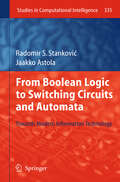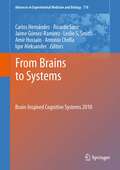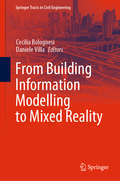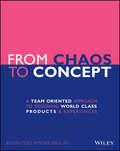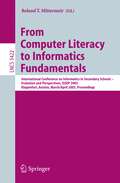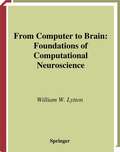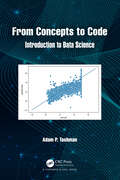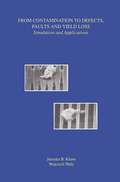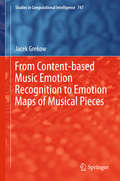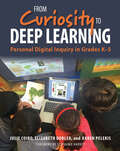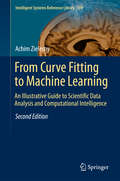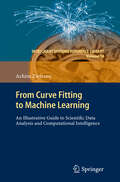- Table View
- List View
From Boolean Logic to Switching Circuits and Automata: Towards Modern Information Technology (Studies in Computational Intelligence #335)
by Radomir S. Stankovic Jaakko AstolaLogic networks and automata are facets of digital systems. The change of the design of logic networks from skills and art into a scientific discipline was possible by the development of the underlying mathematical theory called the Switching Theory. The fundamentals of this theory come from the attempts towards an algebraic description of laws of thoughts presented in the works by George J. Boole and the works on logic by Augustus De Morgan. As often the case in engineering, when the importance of a problem and the need for solving it reach certain limits, the solutions are searched by many scholars in different parts of the word, simultaneously or at about the same time, however, quite independently and often unaware of the work by other scholars. The formulation and rise of Switching Theory is such an example. This book presents a brief account of the developments of Switching Theory and highlights some less known facts in the history of it. The readers will find the book a fresh look into the development of the field revealing how difficult it has been to arrive at many of the concepts that we now consider obvious . Researchers in the history or philosophy of computing will find this book a valuable source of information that complements the standard presentations of the topic.
From Born-Physical to Born-Virtual: 24th International Conference on Asian Digital Libraries, ICADL 2022, Hanoi, Vietnam, November 30 – December 2, 2022, Proceedings (Lecture Notes in Computer Science #13636)
by Yuen-Hsien Tseng Marie Katsurai Hoa N. NguyenThis book constitutes the refereed proceedings of the 24th International Conference on Asia-Pacific Digital Libraries, ICADL 2022, which was held in November/December 2022. The 14 full, 18 short, and 12 poster papers presented in this volume were carefully reviewed and selected from 78 submissions. Based on significant contributions, the full and short papers have been classified into the following topics: intelligent document analysis; neural-based knowledge extraction; knowledge discovery for enhancing collaboration; smart search and annotation; cultural data collection and analysis; scholarly data processing; data archive and management; research activities and digital library; and trends in digital library.
From Brains to Systems: Brain-Inspired Cognitive Systems 2010 (Advances in Experimental Medicine and Biology #718)
by Carlos Hernández, Ricardo Sanz, Jaime Gómez-Ramirez, Leslie S. Smith, Amir Hussain, Antonio Chella and Igor AleksanderBrain Inspired Cognitive Systems - BICS 2010 aims to bring together leading scientists and engineers who use analytic and synthetic methods both to understand the astonishing processing properties of biological systems and specifically of the brain, and to exploit such knowledge to advance engineering methods to build artificial systems with higher levels of cognitive competence. BICS is a meeting point of brain scientists and cognitive systems engineers where cross-domain ideas are fostered in the hope of getting emerging insights on the nature, operation and extractable capabilities of brains. This multiple approach is necessary because the progressively more accurate data about the brain is producing a growing need of a quantitative understanding and an associated capacity to manipulate this data and translate it into engineering applications rooted in sound theories. BICS 2010 is intended for both researchers that aim to build brain inspired systems with higher cognitive competences, and for life scientists who use and develop mathematical and engineering approaches for a better understanding of complex biological systems like the brain. Four major interlaced focal symposia are planned for this conference and these are organized into patterns that encourage cross-fertilization across the symposia topics. This emphasizes the role of BICS as a major meeting point for researchers and practitioners in the areas of biological and artificial cognitive systems. Debates across disciplines will enrich researchers with complementary perspectives from diverse scientific fields. BICS 2010 will take place July 14-16, 2010, in Madrid, Spain.
From Brows to Trust: Evaluating Embodied Conversational Agents (Human–Computer Interaction Series #7)
by Zsófia Ruttkay Catherine PelachaudEmbodied conversational agents (ECAs) are autonomous software entities with human-like appearance and communication skills. These agents can take on a number of different roles, for example, as an assistant, tutor, information provider, or customer service agent. They may also simply represent or entertain a user. The precise nature and benefits of different characteristics of ECAs requires careful investigation. Questions range from the function of an eyebrow raise to mechanisms for assessing and improving ECA trustworthiness. This book will help experts and designers in the specification and development of applications incorporating ECAs. Part 1 provides guidelines for evaluation methodologies and the identification of design and evaluation parameters. Part 2 demonstrates the importance of considering the user's perspective and interaction experience. Part 3 addresses issues in fine-tuning design parameters of ECAs and verifying the perceived effect. Finally, in Part 4 lessons learned from a number of application case studies are presented. The book is intended for both ECA researchers in academia and industry, and developers and designers interested in applying the technology.
From Building Information Modelling to Mixed Reality (Springer Tracts in Civil Engineering)
by Cecilia Bolognesi Daniele VillaThis book reports on the latest advances in using BIM modelling to achieve the semantic enrichment of objects, allowing them to be used both as multidimensional databases – as comprehensive sources of information for finalizing various types of documentation in the building industry – and as modelling tools for the construction of virtual environments. Having advanced to a new stage of development, BIM modelling is now being applied in a range of increasingly complex contexts, and for various new purposes. This book examines the role that virtual reality and related technologies such as AI and IoT can play in preserving and disseminating our cultural heritage and built environment.
From Business Strategy to Information Technology Roadmap: A Practical Guide for Executives and Board Members
by Tiffany Pham David K. Pham Andrew PhamWhether you are a CEO, CFO, board member, or an IT executive, From Business Strategy to Information Technology Roadmap: A Practical Guide for Executives and Board Members lays out a practical, how-to approach to identifying business strategies and creating value-driven technology roadmaps in your organization. Unlike many other books on the subject, you will not find theories or grandiose ideas here. This book uses numerous examples, illustrations, and case studies to show you how to solve the real-world problems that business executives and technology leaders face on a day-to-day basis.Filled with actionable advice you can use immediately, the authors introduce Agile and the Lean mindset in a manner that the people in your business and technology departments can easily understand. Ideal for executives in both the commercial and nonprofit sectors, it includes two case studies: one about a commercial family business that thrived to become a multi-million-dollar company and the other about a nonprofit association based in New York City that fights against child illiteracy.
From Business Strategy to Information Technology Roadmap: A Practical Guide for Executives and Board Members
by Tiffany Pham David K. Pham Andrew PhamWhether you are a CEO, CFO, board member, or an IT executive, From Business Strategy to Information Technology Roadmap: A Practical Guide for Executives and Board Members lays out a practical, how-to approach to identifying business strategies and creating value-driven technology roadmaps in your organization. Unlike many other books on the subject, you will not find theories or grandiose ideas here. This book uses numerous examples, illustrations, and case studies to show you how to solve the real-world problems that business executives and technology leaders face on a day-to-day basis.Filled with actionable advice you can use immediately, the authors introduce Agile and the Lean mindset in a manner that the people in your business and technology departments can easily understand. Ideal for executives in both the commercial and nonprofit sectors, it includes two case studies: one about a commercial family business that thrived to become a multi-million-dollar company and the other about a nonprofit association based in New York City that fights against child illiteracy.
From Cells to Societies: Models of Complex Coherent Action (Springer Series in Synergetics)
by Alexander S. Mikhailov Vera CalenbuhrUsing simple models this book shows how we can gain insights into the behavior of complex systems. It is devoted to the discussion of functional self-organization in large populations of interacting active elements. The authors have chosen a series of models from physics, biochemistry, biology, sociology and economics, and systematically discuss their general properties. The book addresses researchers and graduate students in a variety of disciplines.
From Chaos to Concept: A Team Oriented Approach to Designing World Class Products and Experiences
by Kevin Collamore BraunThis book is written for product design, software development, graphic design, and UX professionals with a focus on creating measurably better user experiences. If you want to design solutions to meet business goals and delight your users, you can look to this resource which covers the following areas: Creating and documenting goals, strategies, objectives, and tactics Defining or refining personas based on your measurable objectives (OKRs) Creating and iterating on scenarios based your prioritized personas A team approach to defining the product and roadmap to address critical use cases Team based divergent ideation and solution exploration Team based convergent solution definition Wireframing potential solutions for rapid research and iteration Using quantitative and qualitative methods to understand usage and test with users Exploring approaches to taxonomy and information architecture Using psychology and human factors to drive your design decisions Developing performant, accessible, maintainable experiences Using analytics to measure the results and inform the next iteration How this process differs based on the size of the company or team that is employing it
From Chaos to Concept: A Team Oriented Approach to Designing World Class Products and Experiences
by Kevin Collamore BraunThis book is written for product design, software development, graphic design, and UX professionals with a focus on creating measurably better user experiences. If you want to design solutions to meet business goals and delight your users, you can look to this resource which covers the following areas: Creating and documenting goals, strategies, objectives, and tactics Defining or refining personas based on your measurable objectives (OKRs) Creating and iterating on scenarios based your prioritized personas A team approach to defining the product and roadmap to address critical use cases Team based divergent ideation and solution exploration Team based convergent solution definition Wireframing potential solutions for rapid research and iteration Using quantitative and qualitative methods to understand usage and test with users Exploring approaches to taxonomy and information architecture Using psychology and human factors to drive your design decisions Developing performant, accessible, maintainable experiences Using analytics to measure the results and inform the next iteration How this process differs based on the size of the company or team that is employing it
From COBOL to OOP (The Morgan Kaufmann Series in Software Engineering and Programming)
by Markus KnasmüllerDriven by the year-2000 problem, the hordes of COBOL developers experienced a renaissance, but the times when COBOL was state-of-the-art are long gone. Object-orientation, application servers, web front-ends, and relational database systems dominate the scene for new projects today. The fact remains however, that millions of lines of source code written in the structured programming language COBOL work daily on computer systems all over the world. One problem that COBOL developers have to deal with on these new projects is familiarity with object-oriented concepts. Markus Knasmüller, rich with experiences of OO projects in COBOL development teams, offers a successful introduction for the experienced COBOL programmer. A careful approach across techniques familiar to COBOL developers and discussions of current standards make this book easily accessible and understandable.*A practical approach to OOP using the concepts and techniques familiar to the experienced COBOL programmer.*Written independently from any specific programming environment, and all programming examples written in both Delphi and Java. *Detailed case study describing the successful migration of 10 million lines of COBOL code to object-oriented programming.*Companion CD-ROM containing all tutorial sections of the book in PowerPoint and all sample solutions to the problems ready for compilation.
From Combinatorics to Philosophy: The Legacy of G.-C. Rota
by Ernesto Damiani Ottavio D'Antona Vincenzo Marra Fabrizio PalombiFrom Combinatorics to Philosophy: The Legacy of G. -C. Rota provides an assessment of G. -C. Rota's legacy to current international research issues in mathematics, philosophy and computer science. This volume includes chapters by leading researchers, as well as a number of invited research papers. Rota’s legacy connects European and Italian research communities to the USA by providing inspiration to several generations of researchers in combinatorics, philosophy and computer science. From Combinatorics to Philosophy: The Legacy of G. -C. Rota is of valuable interest to research institutions and university libraries worldwide. This book is also designed for advanced-level students in mathematics, computer science, and philosophy.
From Complex Sentences to a Formal Semantic Representation using Syntactic Text Simplification and Open Information Extraction
by Christina NiklausThis work presents a discourse-aware Text Simplification approach that splits and rephrases complex English sentences within the semantic context in which they occur. Based on a linguistically grounded transformation stage, complex sentences are transformed into shorter utterances with a simple canonical structure that can be easily analyzed by downstream applications. To avoid breaking down the input into a disjointed sequence of statements that is difficult to interpret, the author incorporates the semantic context between the split propositions in the form of hierarchical structures and semantic relationships, thus generating a novel representation of complex assertions that puts a semantic layer on top of the simplified sentences. In a second step, she leverages the semantic hierarchy of minimal propositions to improve the performance of Open IE frameworks. She shows that such systems benefit in two dimensions. First, the canonical structure of the simplified sentences facilitates the extraction of relational tuples, leading to an improved precision and recall of the extracted relations. Second, the semantic hierarchy can be leveraged to enrich the output of existing Open IE approaches with additional meta-information, resulting in a novel lightweight semantic representation for complex text data in the form of normalized and context-preserving relational tuples.
From Computer Literacy to Informatics Fundamentals: International Conference on Informatics in Secondary Schools -- Evolution and Perspectives, ISSEP 2005, Klagenfurt, Austria, March 30-April 1, 2005, Proceedings (Lecture Notes in Computer Science #3422)
by Roland T. MittermeirFrom Computer to Brain: Foundations of Computational Neuroscience
by William W. LyttonBiology undergraduates, medical students and life-science graduate students often have limited mathematical skills. Similarly, physics, math and engineering students have little patience for the detailed facts that make up much of biological knowledge. Teaching computational neuroscience as an integrated discipline requires that both groups be brought forward onto common ground. This book does this by making ancillary material available in an appendix and providing basic explanations without becoming bogged down in unnecessary details. The book will be suitable for undergraduates and beginning graduate students taking a computational neuroscience course and also to anyone with an interest in the uses of the computer in modeling the nervous system.
From Concepts to Code: Introduction to Data Science
by Adam P. TashmanThe breadth of problems that can be solved with data science is astonishing, and this book provides the required tools and skills fot a broad audience. The reader takes a journey into the forms, uses, and abuses of data and models, and learns how to critically examine each step. Python coding and data analysis skills are built from the ground up, with no prior coding experience assumed. The necessary background in computer science, mathematics, and statistics is provided in an approachable manner.Each step of the machine learning lifecycle is discussed, from business objective planning to monitoring a model in production. This end-to-end approach supplies the broad view necessary to sidestep many of the pitfalls that can sink a data science project. Detailed examples are provided from a wide range of applications and fields, from fraud detection in banking to breast cancer classification in healthcare. The reader will learn the techniques to accomplish tasks that include predicting outcomes, explaining observations, and detecting patterns. Improper use of data and models can introduce unwanted effects and dangers to society. A chapter on model risk provides a framework for comprehensively challenging a model and mitigating weaknesses. When data is collected, stored, and used, it may misrepresent reality and introduce bias. Strategies for addressing bias are discussed. From Concepts to Code: Introduction to Data Science leverages content developed by the author for a full-year data science course suitable for advanced high school or early undergraduate students. This course is freely available and it includes weekly lesson plans.
From Concepts to Code: Introduction to Data Science
by Adam P. TashmanThe breadth of problems that can be solved with data science is astonishing, and this book provides the required tools and skills fot a broad audience. The reader takes a journey into the forms, uses, and abuses of data and models, and learns how to critically examine each step. Python coding and data analysis skills are built from the ground up, with no prior coding experience assumed. The necessary background in computer science, mathematics, and statistics is provided in an approachable manner.Each step of the machine learning lifecycle is discussed, from business objective planning to monitoring a model in production. This end-to-end approach supplies the broad view necessary to sidestep many of the pitfalls that can sink a data science project. Detailed examples are provided from a wide range of applications and fields, from fraud detection in banking to breast cancer classification in healthcare. The reader will learn the techniques to accomplish tasks that include predicting outcomes, explaining observations, and detecting patterns. Improper use of data and models can introduce unwanted effects and dangers to society. A chapter on model risk provides a framework for comprehensively challenging a model and mitigating weaknesses. When data is collected, stored, and used, it may misrepresent reality and introduce bias. Strategies for addressing bias are discussed. From Concepts to Code: Introduction to Data Science leverages content developed by the author for a full-year data science course suitable for advanced high school or early undergraduate students. This course is freely available and it includes weekly lesson plans.
From Contamination to Defects, Faults and Yield Loss: Simulation and Applications (Frontiers in Electronic Testing #5)
by Jitendra B. Khare Wojciech MalyOver the years there has been a large increase in the functionality available on a single integrated circuit. This has been mainly achieved by a continuous drive towards smaller feature sizes, larger dies, and better packing efficiency. However, this greater functionality has also resulted in substantial increases in the capital investment needed to build fabrication facilities. Given such a high level of investment, it is critical for IC manufacturers to reduce manufacturing costs and get a better return on their investment. The most obvious method of reducing the manufacturing cost per die is to improve manufacturing yield. Modern VLSI research and engineering (which includes design manufacturing and testing) encompasses a very broad range of disciplines such as chemistry, physics, material science, circuit design, mathematics and computer science. Due to this diversity, the VLSI arena has become fractured into a number of separate sub-domains with little or no interaction between them. This is the case with the relationships between testing and manufacturing. From Contamination to Defects, Faults and Yield Loss: Simulation and Applications focuses on the core of the interface between manufacturing and testing, i.e., the contamination-defect-fault relationship. The understanding of this relationship can lead to better solutions of many manufacturing and testing problems. Failure mechanism models are developed and presented which can be used to accurately estimate probability of different failures for a given IC. This information is critical in solving key yield-related applications such as failure analysis, fault modeling and design manufacturing.
From Content-based Music Emotion Recognition to Emotion Maps of Musical Pieces (Studies in Computational Intelligence #747)
by Jacek GrekowThe problems it addresses include emotion representation, annotation of music excerpts, feature extraction, and machine learning. The book chiefly focuses on content-based analysis of music files, a system that automatically analyzes the structures of a music file and annotates the file with the perceived emotions. Further, it explores emotion detection in MIDI and audio files. In the experiments presented here, the categorical and dimensional approaches were used, and the knowledge and expertise of music experts with a university music education were used for music file annotation. The automatic emotion detection systems constructed and described in the book make it possible to index and subsequently search through music databases according to emotion. In turn, the emotion maps of musical compositions provide valuable new insights into the distribution of emotions in music and can be used to compare that distribution in different compositions, or to conduct emotional comparisons of different interpretations of the same composition.
From Counterculture to Cyberculture: Stewart Brand, the Whole Earth Network, and the Rise of Digital Utopianism
by Fred TurnerIn the early 1960s, computers haunted the American popular imagination. Bleak tools of the cold war, they embodied the rigid organization and mechanical conformity that made the military-industrial complex possible. But by the 1990s—and the dawn of the Internet—computers started to represent a very different kind of world: a collaborative and digital utopia modeled on the communal ideals of the hippies who so vehemently rebelled against the cold war establishment in the first place. From Counterculture to Cyberculture is the first book to explore this extraordinary and ironic transformation. Fred Turner here traces the previously untold story of a highly influential group of San Francisco Bay–area entrepreneurs: Stewart Brand and the Whole Earth network. Between 1968 and 1998, via such familiar venues as the National Book Award–winning Whole Earth Catalog, the computer conferencing system known as WELL, and, ultimately, the launch of the wildly successful Wired magazine, Brand and his colleagues brokered a long-running collaboration between San Francisco flower power and the emerging technological hub of Silicon Valley. Thanks to their vision, counterculturalists and technologists alike joined together to reimagine computers as tools for personal liberation, the building of virtual and decidedly alternative communities, and the exploration of bold new social frontiers. Shedding new light on how our networked culture came to be, this fascinating book reminds us that the distance between the Grateful Dead and Google, between Ken Kesey and the computer itself, is not as great as we might think.
From CSCW to Web 2.0: Selected Papers from COOP08 (Computer Supported Cooperative Work)
by David Randall Pascal SalembierMany challenges were identified in CSCW some thirty years ago, and some of these remain problematic today. However they are being progressively transformed and this edited volume contains contributions that demonstrate how these new challenges are being dealt with in a variety of ways, reflecting the balance of rigour and creativity that has always characterised the field. Originally presented at COOP ’08 which took place in Carry-le-Rouet, France in 2008, the contributions to this volume have been substantially extended and revised. New technologies, new domains and new methods are described for supporting design and evaluation. Taking a progressive and critical stance, the authors cover a variety of themes including inter-organisational working, non task-based environments, creativity, and the development of Web 2.0 (and even Web 3.0) applications, including new cooperative mechanisms and new classification possibilities.
From Curiosity to Deep Learning: Personal Digital Inquiry in Grades K-5
by Julie Coiro Elizabeth Dobler Karen PelekisFrom Curiosity to Deep Learning: Personal Digital Inquiry in Grades K-5 reveals the powerful learning that results when you integrate purposeful technology into a classroom culture that values curiosity and deep learning. The centerpiece of this practical guide is Personal Digital Inquiry (PDI), a framework developed by Julie Coiro and implemented in classrooms by her co-authors, Elizabeth Dobler and Karen Pelekis. Clear, detailed examples offer ideas for K-5 teachers and school librarians to support their teaching.Personal emphasizes the significance of the personal relationship between teachers and students, and the role that students have in the learning process. Digital reflects the important role that digital texts and tools have come to play in both learning and teaching with inquiry. Inquiry lies at the core of PDI, because learners grow and change with opportunities to identify problems, generate personal wonderings, and engage in collaborative dialogue, making learning relevant and lasting.From Curiosity to Deep Learning: Personal Digital Inquiry in Grades K-5 shows you how to integrate inquiry with a range of digital tools and resources that will create a dynamic classroom for both you and your students.
From Curiosity to Deep Learning: Personal Digital Inquiry in Grades K-5
by Julie Coiro Elizabeth Dobler Karen PelekisFrom Curiosity to Deep Learning: Personal Digital Inquiry in Grades K-5 reveals the powerful learning that results when you integrate purposeful technology into a classroom culture that values curiosity and deep learning. The centerpiece of this practical guide is Personal Digital Inquiry (PDI), a framework developed by Julie Coiro and implemented in classrooms by her co-authors, Elizabeth Dobler and Karen Pelekis. Clear, detailed examples offer ideas for K-5 teachers and school librarians to support their teaching.Personal emphasizes the significance of the personal relationship between teachers and students, and the role that students have in the learning process. Digital reflects the important role that digital texts and tools have come to play in both learning and teaching with inquiry. Inquiry lies at the core of PDI, because learners grow and change with opportunities to identify problems, generate personal wonderings, and engage in collaborative dialogue, making learning relevant and lasting.From Curiosity to Deep Learning: Personal Digital Inquiry in Grades K-5 shows you how to integrate inquiry with a range of digital tools and resources that will create a dynamic classroom for both you and your students.
From Curve Fitting to Machine Learning: An Illustrative Guide to Scientific Data Analysis and Computational Intelligence (Intelligent Systems Reference Library #109)
by Achim ZielesnyThis successful book provides in its second edition an interactive and illustrative guide from two-dimensional curve fitting to multidimensional clustering and machine learning with neural networks or support vector machines. Along the way topics like mathematical optimization or evolutionary algorithms are touched. All concepts and ideas are outlined in a clear cut manner with graphically depicted plausibility arguments and a little elementary mathematics.The major topics are extensively outlined with exploratory examples and applications. The primary goal is to be as illustrative as possible without hiding problems and pitfalls but to address them. The character of an illustrative cookbook is complemented with specific sections that address more fundamental questions like the relation between machine learning and human intelligence.All topics are completely demonstrated with the computing platform Mathematica and the Computational Intelligence Packages (CIP), a high-level function library developed with Mathematica's programming language on top of Mathematica's algorithms. CIP is open-source and the detailed code used throughout the book is freely accessible.The target readerships are students of (computer) science and engineering as well as scientific practitioners in industry and academia who deserve an illustrative introduction. Readers with programming skills may easily port or customize the provided code. "'From curve fitting to machine learning' is ... a useful book. ... It contains the basic formulas of curve fitting and related subjects and throws in, what is missing in so many books, the code to reproduce the results.All in all this is an interesting and useful book both for novice as well as expert readers. For the novice it is a good introductory book and the expert will appreciate the many examples and working code". Leslie A. Piegl (Review of the first edition, 2012).
From Curve Fitting to Machine Learning: An Illustrative Guide to Scientific Data Analysis and Computational Intelligence (Intelligent Systems Reference Library #18)
by Achim ZielesnyThe analysis of experimental data is at heart of science from its beginnings. But it was the advent of digital computers that allowed the execution of highly non-linear and increasingly complex data analysis procedures - methods that were completely unfeasible before. Non-linear curve fitting, clustering and machine learning belong to these modern techniques which are a further step towards computational intelligence.The goal of this book is to provide an interactive and illustrative guide to these topics. It concentrates on the road from two dimensional curve fitting to multidimensional clustering and machine learning with neural networks or support vector machines. Along the way topics like mathematical optimization or evolutionary algorithms are touched. All concepts and ideas are outlined in a clear cut manner with graphically depicted plausibility arguments and a little elementary mathematics. The major topics are extensively outlined with exploratory examples and applications. The primary goal is to be as illustrative as possible without hiding problems and pitfalls but to address them. The character of an illustrative cookbook is complemented with specific sections that address more fundamental questions like the relation between machine learning and human intelligence. These sections may be skipped without affecting the main road but they will open up possibly interesting insights beyond the mere data massage.All topics are completely demonstrated with the aid of the commercial computing platform Mathematica and the Computational Intelligence Packages (CIP), a high-level function library developed with Mathematica's programming language on top of Mathematica's algorithms. CIP is open-source so the detailed code of every method is freely accessible. All examples and applications shown throughout the book may be used and customized by the reader without any restrictions. The target readerships are students of (computer) science and engineering as well as scientific practitioners in industry and academia who deserve an illustrative introduction to these topics. Readers with programming skills may easily port and customize the provided code.
